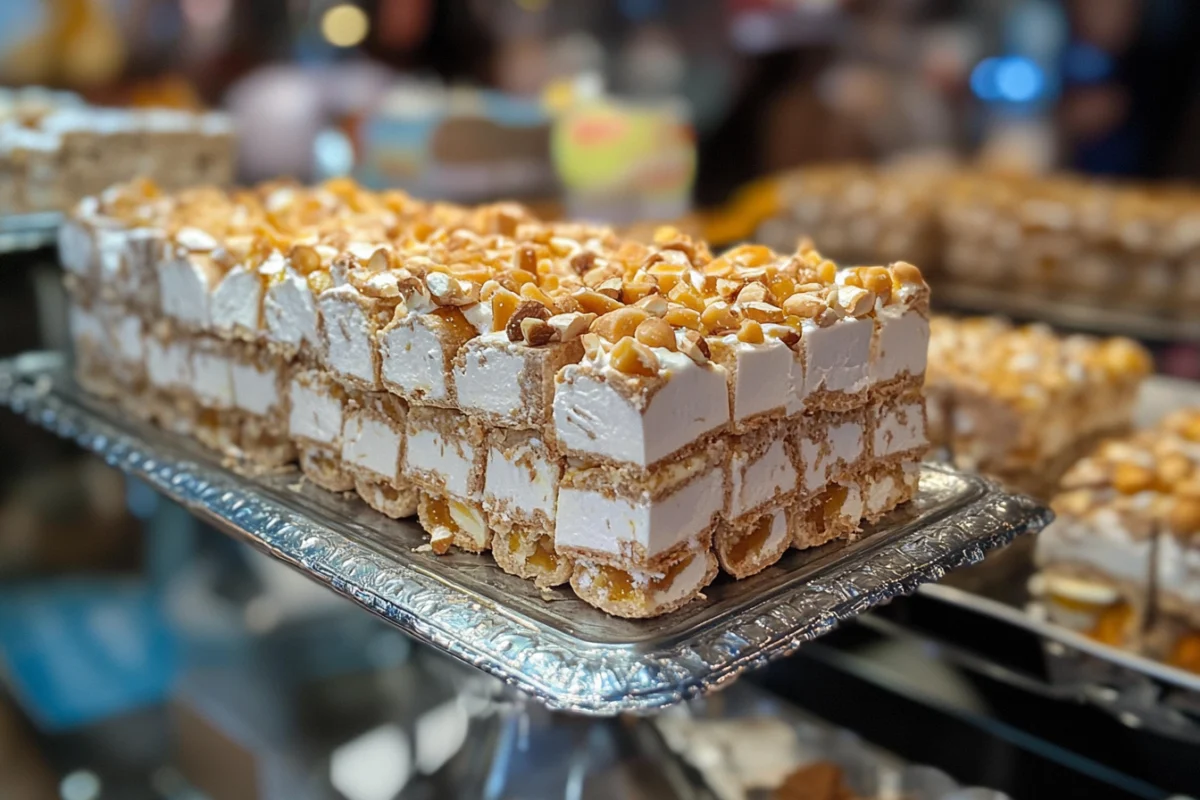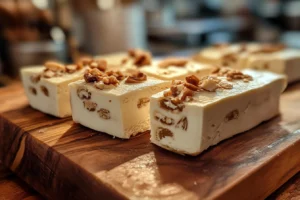Turrón is a traditional dessert enjoyed across the world, particularly in Mexico, where it has been adapted to suit local tastes and ingredients. While turrón originated in Spain, the Mexican version, especially the pink turrón, has gained immense popularity, particularly during festive seasons like Christmas.
- What is Turrón?
Turrón is a sweet, nougat-like candy made with almonds, honey, and sugar. In Mexico, it has evolved to include unique ingredients and flavors that make it distinctly different from its Spanish counterpart. - The Role of Pink Turrón in Mexican Cuisine
Pink turrón stands out not only because of its vibrant color but also due to its delicate blend of sweetness and festive appeal. It’s commonly associated with Mexican Christmas celebrations and other special occasions.
For a deeper dive into the different kinds of turrón, including its preparation and significance in Mexican culture, you can explore What is Spanish turrón? A guide. This guide explores the origins of turrón in Spain and how the treat has evolved over time into various regional versions, including the one that is now beloved in Mexico.
What is Turrón?
Turrón is a traditional candy that dates back centuries, originating in Spain. Its basic ingredients typically include:
- Almonds
- Honey
- Sugar
- Egg whites
The texture and flavor of turrón vary depending on its preparation. There are two main types of turrón: soft turrón (turrón de Jijona) and hard turrón (turrón de Alicante). While both are delicious, the Mexican version of turrón has evolved to feature local variations, including the popular pink variety.
- Turrón’s Evolution in Mexico
In Mexico, turrón has adapted to the country’s rich culinary traditions. The Mexican pink turrón, for example, often incorporates additional ingredients like coconut, rose or strawberry essence, and food coloring, giving it a unique flavor and appearance compared to the Spanish varieties.
Turrón in Mexican Cuisine
In Mexico, turrón is more than just a dessert. It’s a part of the cultural fabric, especially during Christmas and other important celebrations.
- Significance of Turrón in Celebrations
Turrón is typically enjoyed during major Mexican holidays, especially during Christmas. Families often prepare this sweet treat at home, though it’s also available from local vendors and specialty stores during the festive season. - Regional Variations
Across Mexico, there are different variations of turrón, depending on the region. For example:- In Veracruz, turrón might be prepared with additional tropical flavors like coconut or pineapple.
- In Jalisco, turrón is often made with nuts like peanuts and can have a crunchy texture.
- Mexican Flavors Influencing Turrón
Mexican cuisine is known for its bold flavors, and these influences can be seen in pink turrón. Ingredients such as cinnamon, vanilla, and even a hint of chili have found their way into various turrón recipes, making it an unforgettable treat.
What is Pink Turrón?
The pink turrón is a variation of the traditional Mexican turrón that is visually distinct due to its rosy hue. Here’s what makes pink turrón so special:
- Color and Flavor
The pink color is typically achieved through food coloring or natural ingredients like rose essence or strawberry flavor. This makes the dessert stand out and adds a sweet, fruity element to the traditional turrón. - Ingredients of Pink Turrón
While the basic ingredients are similar to traditional turrón (such as almonds, honey, and sugar), pink turrón may also include:- Coconut flakes for texture.
- Rose or strawberry essence for flavor.
- A touch of food coloring for its signature pink hue.
- Presentation of Pink Turrón
Pink turrón is often shaped into rectangular or square blocks and wrapped in decorative paper, making it an ideal gift during the holiday season. Its vibrant pink color adds a festive touch to any table.
How is Pink Turrón Made?
The process of making pink turrón follows similar steps to that of traditional turrón but with a few variations that make it unique:
- Ingredients Preparation
- Almonds are roasted and chopped.
- Sugar and honey are combined to create a syrupy mixture.
- Coconut flakes and rose essence are added to the mixture for flavor.
- Cooking Process
The mixture is carefully cooked until it thickens, then poured into molds to set. The distinctive pink color comes from food coloring or natural ingredients. - Cooling and Setting
Once the mixture is in the mold, it is allowed to cool and harden. The end result is a firm, slightly chewy treat that is full of flavor and color. - Modern vs. Traditional Methods
While traditional pink turrón is made by hand, modern methods may use machines to streamline the process. This has led to variations in texture and flavor but has also made it easier for the treat to be mass-produced.
Cultural Significance, Variations, and FAQs
Cultural Significance of Pink Turrón in Mexico
Pink turrón holds a special place in Mexican culinary traditions, especially during the festive season. Its vibrant color and unique flavor make it a standout treat during celebrations.
- A Symbol of Festivity
Pink turrón is commonly associated with Christmas and is often seen as a symbol of joy, family, and togetherness. The colorful treat is typically shared among family members during holiday meals, making it a part of cherished traditions. - Role in Mexican Celebrations
It’s not just Christmas where pink turrón shines; it’s also enjoyed during special events like Día de los Muertos (Day of the Dead) and Las Posadas. During these celebrations, families gather to share food, music, and stories, and pink turrón is a beloved dessert that adds a sweet touch to these occasions. - Cultural Connections to Mexican Flavors
In Mexico, colors have deep symbolic meanings. The vibrant pink hue of turrón might represent celebration, warmth, and community. The flavor profile, often infused with rose or strawberry essence, adds a uniquely Mexican twist that resonates with the country’s penchant for bold, sweet flavors.
Where to Find Pink Turrón in Mexico?
Finding authentic pink turrón in Mexico can be an exciting adventure, as it is often made by local artisans and specialty vendors during the holiday season.
- Regions Known for Pink Turrón
While pink turrón is enjoyed across Mexico, certain regions are particularly known for producing high-quality versions.- In Jalisco, pink turrón is a staple in holiday markets.
- Veracruz is another region where artisanal turrón, including pink turrón, is crafted using local coconut and tropical flavors.
- Artisan vs. Commercial Pink Turrón
Handmade pink turrón is often more sought after due to its authenticity. Local artisans use fresh ingredients and traditional methods, giving the turrón a richer flavor and smoother texture.
In contrast, commercial versions might be found in supermarkets and stores, typically during the holiday season, but they may lack the same quality or customization. - Purchasing Pink Turrón Online
With the rise of online shopping, it’s now easier than ever to find pink turrón outside of Mexico. Many artisan vendors sell it online, allowing people in the U.S., Canada, and beyond to enjoy this festive treat.
Pink Turrón vs. Traditional Turrón
While both pink turrón and traditional turrón share the same basic ingredients, there are distinct differences in flavor, appearance, and preparation methods.
- Key Differences in Flavor and Texture
Traditional Spanish turrón is typically made with almonds, honey, and sugar, resulting in a rich, nutty flavor with a firm texture.
In comparison, pink turrón features:- A sweeter, more delicate flavor from rose essence or strawberry.
- A softer, chewier texture, often due to the addition of coconut or other ingredients.
- Regional Variations of Turrón in Mexico
Pink turrón is just one of many regional variations found across Mexico. While some places stick to the classic almond-based recipes, others have incorporated unique flavors and textures, such as:- Turrón de coco (coconut turrón).
- Turrón de dulce de leche (caramelized milk turrón).
- Global Appeal of Pink Turrón
As Mexican cuisine continues to gain popularity around the world, pink turrón is making its way into international markets. Its unique flavor and festive color have earned it a place in diverse cultural celebrations, particularly around Christmas.
Benefits of Eating Pink Turrón
While pink turrón is undoubtedly a treat to indulge in, it also offers some benefits, especially if enjoyed in moderation.
- Nutritional Benefits
Pink turrón typically contains almonds, which are a source of healthy fats, protein, and antioxidants. In addition, the coconut flakes used in some recipes provide dietary fiber and minerals. However, like most sweets, it is high in sugar and should be eaten sparingly. - A Sweet Source of Energy
The combination of honey, sugar, and nuts provides a quick energy boost, making it a popular treat during festive times when people need a little pick-me-up. - Rich in Flavor and Tradition
In addition to its nutritional value, pink turrón represents a piece of Mexican heritage. By indulging in this dessert, you’re connecting with a long-standing tradition of festive Mexican sweets and celebrating the richness of local culinary history.
How to Serve Pink Turrón?
Pink turrón can be served in a variety of ways, depending on the occasion and personal preferences. Here are some ideas for enjoying this colorful dessert:
- As Part of a Holiday Feast
Serve pink turrón alongside other traditional Mexican desserts like buñuelos, romeritos, and tamales. The vibrant pink color pairs beautifully with other festive foods. - Creative Serving Ideas
- Cut the turrón into bite-sized pieces for easy sharing during parties or family gatherings.
- Pair it with hot beverages like café de olla or Mexican hot chocolate for a warm, comforting experience.
- Storage Tips
To preserve the flavor and texture of pink turrón, store it in an airtight container in a cool, dry place. It can last for a few weeks if kept properly, making it an excellent gift during the holiday season.
FAQs
- What is the difference between pink turrón and regular turrón?
Pink turrón is made with additional flavorings like rose essence or strawberry, which give it a lighter, sweeter taste. It also has a soft, chewy texture, whereas traditional turrón tends to be firmer and more nutty. - Can I make pink turrón at home?
Yes! Making pink turrón at home is easy. You’ll need almonds, honey, sugar, coconut flakes, and food coloring or rose essence to achieve the distinctive pink hue. - Where can I buy authentic pink turrón in the U.S.?
Many online retailers specialize in authentic Mexican products, including pink turrón. Check out websites like MexGrocer or La Tienda for reliable sources of Mexican sweets. - Is pink turrón suitable for vegetarians?
Yes, pink turrón is typically vegetarian, as it’s made with plant-based ingredients like almonds, honey, and coconut. However, always check the label for any animal-based additives. - How long does pink turrón last?
When stored properly in an airtight container, pink turrón can last for 2-3 weeks. If you’re making it at home, it’s best enjoyed within a week for maximum freshness. - What are the best pairings for pink turrón?
Pink turrón pairs wonderfully with Mexican hot chocolate, café de olla, or even a light fruit salad. The sweetness of the turrón complements the rich flavors of these beverages.
Conclusion and Related Information
Conclusion
In conclusion, pink turrón is a unique and beloved dessert in Mexican cuisine. Its vibrant color, sweet flavor, and cultural significance make it a standout treat during holiday celebrations, especially Christmas. The combination of almonds, honey, coconut, and rose or strawberry essence gives pink turrón a distinctive flavor profile that sets it apart from traditional Spanish turrón and other Mexican sweets.
- A Cultural Symbol
Pink turrón is more than just a dessert; it represents the spirit of family, celebration, and togetherness during special occasions. Whether homemade or bought from local vendors, it plays a vital role in Mexican holiday traditions. - Growing Popularity
As global interest in Mexican cuisine continues to rise, pink turrón is gaining recognition outside of Mexico. Its colorful appearance and delicious flavor have made it a popular choice for festive gatherings, not only in Mexico but in other parts of the world. - Making Your Own Pink Turrón
If you’re feeling inspired to create this treat at home, the recipe is simple and versatile, allowing you to adjust ingredients to suit your taste. Whether you prefer a more nutty flavor, a lighter texture, or extra coconut, the possibilities are endless.
Pink turrón continues to bring joy to families, offering a sweet way to celebrate Mexican culture and traditions.
Related Information
If you’re interested in exploring more about Mexican desserts or turrón variations, check out these related topics:
- Mexican Christmas Traditions: Discover other festive foods enjoyed during Las Posadas and Nochebuena.
- Mexican Sweets and Candies: Learn about other iconic Mexican sweets like cajeta, alegría, and chocolate caliente.
- Turrón Around the World: Compare the different regional variations of turrón, from Spain to Mexico and beyond.



